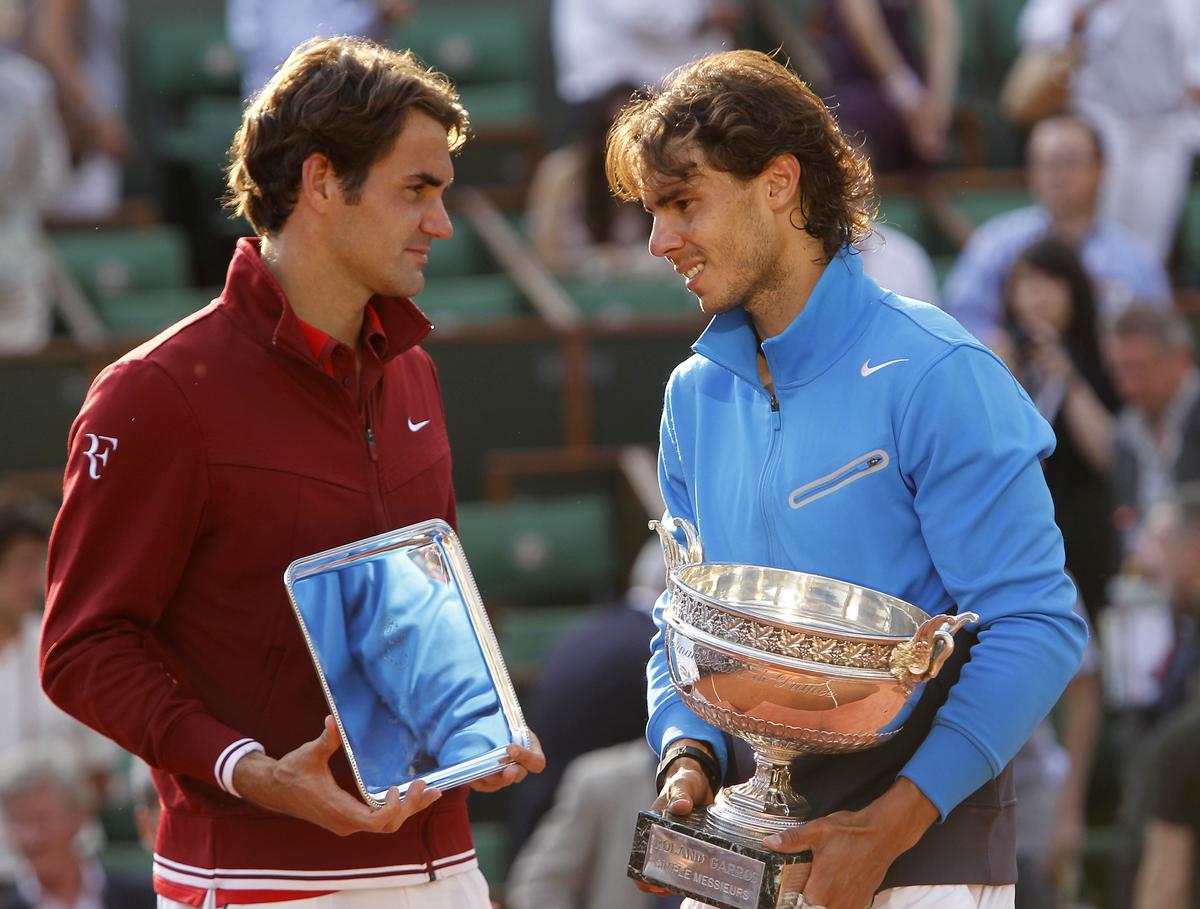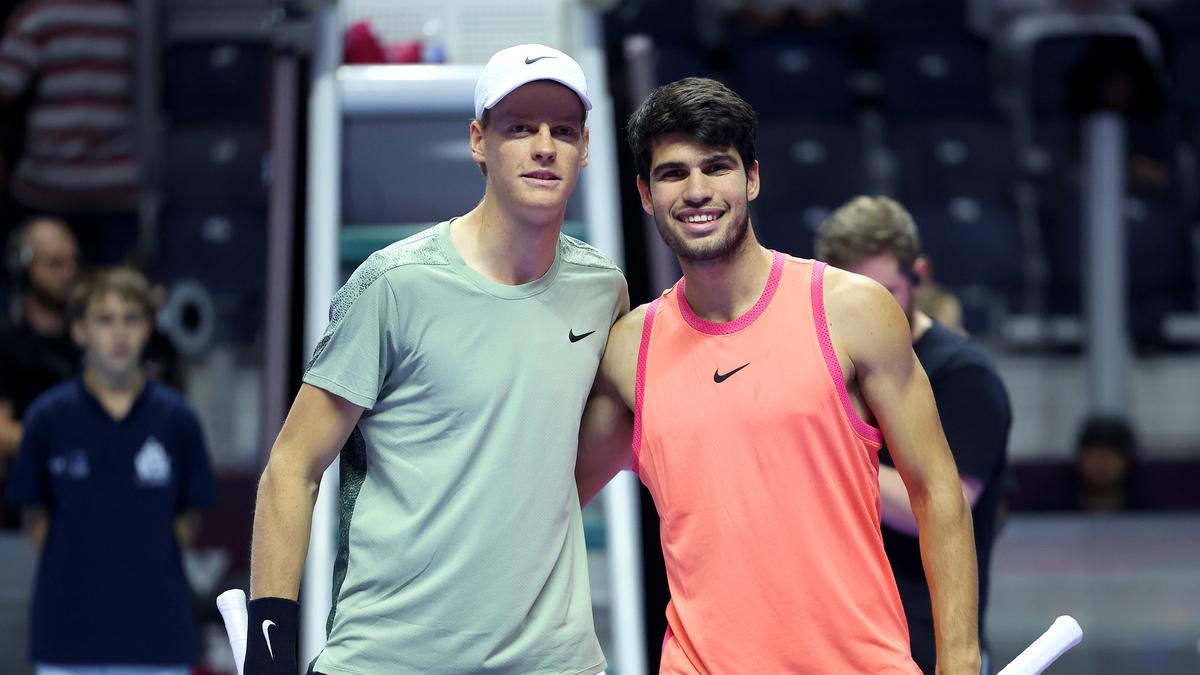During Jannik Sinner’s 7-6(4), 6-3 victory over 24-time Major champion Novak Djokovic in the Shanghai Masters final, Carlos Alcaraz, seated next to Roger Federer, was seen listening intently to the latter’s conversation with Juan Carlos Ferrero.
What could Alcaraz, coached by the astute Ferrero, have learned about technique, tactics, and other relevant topics from 20-time Major winner Federer, one of the smartest players in tennis history?
And how can Alcaraz use that knowledge against Sinner, Djokovic, and the best of the rest, including rookie sensation Giovanni Mpetshi Perricard, a 6’8” monster server?
This observer would love to know how Federer coped with and rebounded quickly from heartbreaking defeats, such as his record 24 losses after holding one or more match points. How the Swiss maestro controlled his penchant for crowd-pleasing but high-risk trick shots, particularly on critical points, and why he rarely suffered major injuries or lost his passion for practice and competition.
READ | Trick shots in tennis — key to unlocking ultimate sporting success?
Just 11 days earlier, Alcaraz had defeated Sinner for the third straight time — a 6-7(6), 6-4, 7-6(3) thriller in the China Open final in Beijing. Meanwhile, the Shanghai Open final victory was Sinner’s third consecutive against Djokovic.

Mirroring the legends: The budding rivalry and friendship between Alcaraz and Sinner draws a clear parallel to the early dynamics between Roger Federer (left) and Rafael Nadal (right).
| Photo Credit:
AP
Mirroring the legends: The budding rivalry and friendship between Alcaraz and Sinner draws a clear parallel to the early dynamics between Roger Federer (left) and Rafael Nadal (right).
| Photo Credit:
AP
Asked about the similarities between his game and Sinner’s, The Djoker offered this serious, accurate appraisal. “All around, he has every shot in the game. He’s improved his serve tremendously. I think that became a big weapon. He’s just very aggressive from the baseline; as soon as he’s got a shorter ball, he’s taking the initiative. Just very solid from forehand and backhand, doesn’t make too many mistakes, and just tries to take away the time from the opponent.
“That’s something that reminds me of myself throughout my career, that’s what I’ve done for so many years consistently,” said Djokovic. “Playing fast-paced tennis, taking away time from the opponent, suffocating the opponent, in a certain way. You want your opponent to always feel under pressure from your shots, from your speed, from your presence on the court. So, he’s got that. This year he’s been so consistent. It’s really, really impressive.”
The stats confirm Sinner’s improved serving. On hard courts, where he captured his first two Grand Slam titles this season, he has held serve a superb 91 per cent of the time compared to 82 per cent in 2022 and 88 per cent in 2023. The hard-court parallel between Sinner, albeit very early in his career, and Djokovic, the undisputed King of Hard Courts, is noteworthy. The Serb seized 14 of his record 24 Majors on hard courts, where he won an outstanding 87 per cent of his service games.
Stylistic comparisons
“We can define Sinner and Alcaraz as the Djokovic and Federer of the future, although we must keep the proper proportions,” Boris Becker had told the Italian publication, La Gazzetta dello Sport.
“Roger and Nole have made history in this sport, as has Rafa Nadal. Alcaraz’s style of play, in terms of beauty, is more similar to that of the Swiss, although his idol has always been Rafa.
Two of a kind: It takes phenomenal athleticism, versatility, and creativity to replicate Federer and Alcaraz, who successfully modelled his game after Federer, albeit with a two-handed backhand.
| Photo Credit:
GETTY IMAGES
Two of a kind: It takes phenomenal athleticism, versatility, and creativity to replicate Federer and Alcaraz, who successfully modelled his game after Federer, albeit with a two-handed backhand.
| Photo Credit:
GETTY IMAGES
“From a purely stylistic point of view, the Spaniard can be compared to Federer and the Italian to Djokovic. However, we now have another dilemma on the circuit. We need a ‘Nadal’ to complete the new Big Three and another player to follow the Fab Four.”
In truth, men’s tennis doesn’t need a Fab Four. And it had one only from 2012 to 2016. That is when Andy Murray captured two Wimbledon titles, one US Open, and two Olympic gold medals. For their entire 20-plus year careers, however, Andy’s overall record wound up a distant fourth behind the Big Three, not to mention 1990s superstar and 14-time Major winner Pete Sampras.
The speedy Murray also lacked a signature shot or feared weapon, which accounted for his losing eight of 11 Grand Slam finals.
The extraordinary heights the legendary Big Three and the new Big Two have reached will be difficult to emulate. That said, more world-class players play ‘like’ the conventional stylists, Djokovic and Sinner. However, it takes phenomenal athleticism, versatility, and creativity to replicate Federer and Alcaraz, who successfully modelled his game after Federer, albeit with a two-handed backhand.
ALSO READ | The missing link: The connection between technique and tactics
This leaves Nadal, whose lefty game was based on the best forehand — on clay, anyway, due to its ferocious topspin and consistency—in tennis history, extremely high-percentage shot selection, and an intimidating, never-say-die competitiveness. Sooner or later, these assets broke down opponents’ strokes, bodies, and spirits.
Not far from the best: The hard-court parallel between Sinner, albeit very early in his career, and Djokovic, the undisputed King of Hard Courts, is noteworthy.
| Photo Credit:
AFP
Not far from the best: The hard-court parallel between Sinner, albeit very early in his career, and Djokovic, the undisputed King of Hard Courts, is noteworthy.
| Photo Credit:
AFP
In my view, Rafa’s unique playing style will prove the hardest to emulate and master, particularly given that only about 10 per cent of world-class players are typically left-handed.
Greatest ever achievement
A British newspaper that regularly offers readers polls, recently asked: “What is the greatest achievement in the history of men’s tennis?” The options were:
-Rafael Nadal winning the French Open 14 times
-Bjorn Borg’s 49-match winning streak
-Roger Federer’s 237 consecutive weeks as world No.1
-Novak Djokovic winning 24 Grand Slams
-Rod Laver winning all four Grand Slams in the same year
All-rounder: Djokovic’s complete game flourished on every surface: 14 Major titles on hard courts, seven on grass, and three on clay, plus an Olympic gold medal on clay.
| Photo Credit:
Getty Images
All-rounder: Djokovic’s complete game flourished on every surface: 14 Major titles on hard courts, seven on grass, and three on clay, plus an Olympic gold medal on clay.
| Photo Credit:
Getty Images
This analyst picks Djokovic’s achievement for two reasons. First, total career Major titles on all surfaces matter much more than total career Major titles on any one surface — which is Nadal’s astounding achievement. And the splendid Serb’s all-time men’s record matters much more than any winning streak. (Would you rather win five straight Wimbledon titles as Borg did, or six total Wimbledon titles non-consecutively? The answer should be easy.)
Second, Djokovic’s complete game flourished on every surface: 14 Major titles on hard courts, seven on grass, and three on clay, plus an Olympic gold medal on clay.
However, ‘the greatest achievement’ is distinctly different from the ‘most unbreakable record’. For example, it is hard to conceive of any man surpassing Laver by capturing two calendar-year Grand Slams, and even more inconceivable if you count his 1962 Grand Slam during the Amateur Era (a feat diminished because pro champions Pancho Gonzalez, Ken Rosewall, and Lew Hoad were not eligible).
If we change the question to ‘What is the most unbreakable career record of great consequence?’— disqualifying Jimmy Connors’ five US Open titles on three different surfaces — my pick is Nadal’s unfathomable conquest of Roland Garros 14 times.
The modest Spaniard said he never thought he was “special”, but the sports world disagreed. His coronation as The King of Clay is an understatement considering that his closest contender, Bjorn Borg, amassed six French crowns, fewer than half of Nadal’s haul.
Lastly, this sportswriter wondered if Federer, who enjoyed a 24-year pro career, discussed with Ferrero the keys to his long and brilliant career. If he did, rest assured Alcaraz won’t share that top-secret information with arch-rival Sinner.
To their credit, the new Big Two have already emulated the initial era of the Fedal rivalry by winning Grand Slams and becoming good friends.
Now that’s a feat to celebrate.

